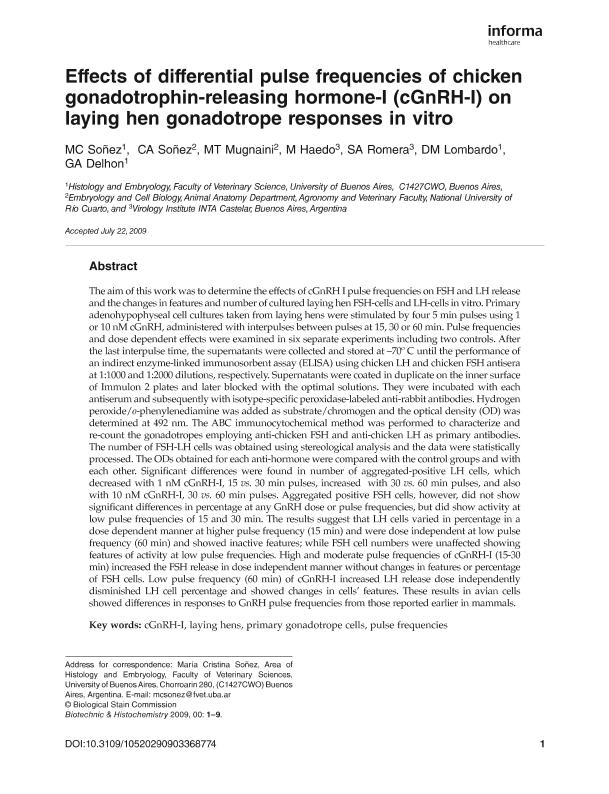Artículo
Effects of differential pulse frequencies of chicken gonadotrophin-releasing hormone-I (cGnRH-I) on laying hen gonadotrope responses in vitro
Soñez, María Cristina; Soñez, Carlos Alberto; Mugnaini, María Teresa; Haedo, Mariana; Romera, Sonia ; Lombardo, Daniel Marcelo
; Lombardo, Daniel Marcelo ; Delhon, Gustavo Alfredo
; Delhon, Gustavo Alfredo
 ; Lombardo, Daniel Marcelo
; Lombardo, Daniel Marcelo ; Delhon, Gustavo Alfredo
; Delhon, Gustavo Alfredo
Fecha de publicación:
12/2010
Editorial:
Informa Healthcare
Revista:
Biotechnic and Histochemistry
ISSN:
1052-0295
e-ISSN:
1473-7760
Idioma:
Inglés
Tipo de recurso:
Artículo publicado
Clasificación temática:
Resumen
The aim of this work was to determine the effects of cGnRH I pulse frequencies on FSH and LH release and the changes in features and number of cultured laying hen FSH-cells and LH-cells in vitro. Primary adenohypophyseal cell cultures taken from laying hens were stimulated by four 5 min pulses using 1 or 10 nM cGnRH, administered with interpulses between pulses at 15, 30 or 60 min. Pulse frequencies and dose dependent effects were examined in six separate experiments including two controls. After the last interpulse time, the supernatants were collected and stored at –70º C until the performance of an indirect enzyme-linked immunosorbent assay (ELISA) using chicken LH and chicken FSH antisera at 1:1000 and 1:2000 dilutions, respectively. Supernatants were coated in duplicate on the inner surface of Immulon 2 plates and later blocked with the optimal solutions. They were incubated with each antiserum and subsequently with isotype-specific peroxidase-labeled anti-rabbit antibodies. Hydrogen peroxide/o-phenylenediamine was added as substrate/chromogen and the optical density (OD) was determined at 492 nm. The ABC immunocytochemical method was performed to characterize and re-count the gonadotropes employing anti-chicken FSH and anti-chicken LH as primary antibodies. The number of FSH-LH cells was obtained using stereological analysis and the data were statistically processed. The ODs obtained for each anti-hormone were compared with the control groups and with each other. Significant differences were found in number of aggregated-positive LH cells, which decreased with 1 nM cGnRH-I, 15 vs. 30 min pulses, increased with 30 vs. 60 min pulses, and also with 10 nM cGnRH-I, 30 vs. 60 min pulses. Aggregated positive FSH cells, however, did not show significant differences in percentage at any GnRH dose or pulse frequencies, but did show activity at low pulse frequencies of 15 and 30 min. The results suggest that LH cells varied in percentage in a dose dependent manner at higher pulse frequency (15 min) and were dose independent at low pulse frequency (60 min) and showed inactive features; while FSH cell numbers were unaffected showing features of activity at low pulse frequencies. High and moderate pulse frequencies of cGnRH-I (15-30 min) increased the FSH release in dose independent manner without changes in features or percentage of FSH cells. Low pulse frequency (60 min) of cGnRH-I increased LH release dose independently disminished LH cell percentage and showed changes in cells’ features. These results in avian cells showed differences in responses to GnRH pulse frequencies from those reported earlier in mammals.
Palabras clave:
CGNRH-I
,
LAYING HENS
,
PRIMARY GONADOTROPE CELLS
,
PULSE FREQUENCIES
Archivos asociados
Licencia
Identificadores
Colecciones
Articulos(SEDE CENTRAL)
Articulos de SEDE CENTRAL
Articulos de SEDE CENTRAL
Citación
Soñez, María Cristina; Soñez, Carlos Alberto; Mugnaini, María Teresa; Haedo, Mariana; Romera, Sonia; et al.; Effects of differential pulse frequencies of chicken gonadotrophin-releasing hormone-I (cGnRH-I) on laying hen gonadotrope responses in vitro; Informa Healthcare; Biotechnic and Histochemistry; 85; 6; 12-2010; 355-363
Compartir
Altmétricas



